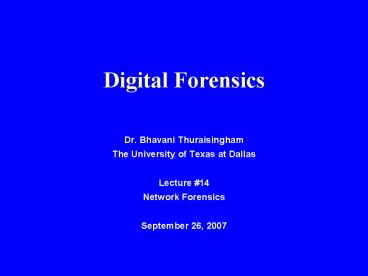Digital Forensics PowerPoint PPT Presentation
1 / 16
Title: Digital Forensics
1
Digital Forensics
- Dr. Bhavani Thuraisingham
- The University of Texas at Dallas
- Lecture 14
- Network Forensics
- September 26, 2007
2
Outline
- Review of Lectures 11 and 12
- Network Forensics
- Conclusion and Links
- References
- Chapter 12 of text book
- Additional links given at the end
3
Review of Lectures 11, 12 and 13
- Lecture 11
- Review of Part II
- Digital Forensics Analysis Techniques
- Reconstructing past events
- Conclusion and Links
- Lecture 12
- Guest lecture Honeynets
- Lecture 13
- Guest lecture Richardson Police Department
4
Network Forensics
- What is Network Forensics?
- http//searchsecurity.techtarget.com/sDefinition/0
,,sid14_gci859579,00.html - Network Forensics Analysis
- Relationship to Honeynets/Honeypots
- Policies for Networks Forensics
- Example Prototype System
- Some Popular Networks Forensics Analysis Tools
(NFAT)
5
What is Network Forensics?
- Network forensics is the capture, recording, and
analysis of network events in order to discover
the source of security attacks or other problem
incidents. - Network forensics systems can be one of two
kinds - "Catch-it-as-you-can" systems, in which all
packets passing through a certain traffic point
are captured and written to storage with analysis
being done subsequently in batch mode. This
approach requires large amounts of storage,
usually involving a RAID system. - "Stop, look and listen" systems, in which each
packet is analyzed in a rudimentary way in memory
and only certain information saved for future
analysis. This approach requires less storage but
may require a faster processor to keep up with
incoming traffic.
6
Network Forensics Analysis Tools (NFAT)
Relationships between IDS, Firewalls and NFAT
- IDS attempts to detect activity that violates an
organizations security policy by implementing a
set of rules describing preconfigures patterns of
interest - Firewall allows or disallows traffic to or from
specific networks, machine addresses and port
numbers - NFAT synergizes with IDSs and Firewalls.
- Preserves long term record of network traffic
- Allows quick analysis of trouble spots identified
by IDSs and Firewalls - NFATs must do the following
- Capture network traffic
- Analyze network traffic according to user needs
- Allow system users discover useful and
interesting things about the analyzed traffic
7
NFAT Tasks
- Traffic Capture
- What is the policy?
- What is the traffic of interest?
- Intermal/Externasl?
- Collect packets tcpdump
- Traffic Analysis
- Sessionizing captured traffic (organize)
- Protocol Parsing and analysis
- Check for strings, use expert systems for
analysis - Interacting with NFAT
- Appropriate user interfaces, reports, examine
large quantities of information and make it
manageable
8
Honeynets/Honeypots
- Network Forensics and honeynet systems have the
same features of collecting information about
computer misuses - Honeynet system can lure attackers and gain
information about new types of intrusions - Network forensics systems analyze and reconstruct
he attack behaviors - These two systems integrated together build a
active self learning and response system to
profile the intrusion behavior features and
investigate the original source of the attack.
9
Policies Computer Attack Taxonomy
- Probing
- Attackers reconnaissance
- Attackers create a profile of an organization's
structure, network capabilities and content,
security posture - Attacker finds the targets and devices plans to
circumvent the security mechanism - Penetration
- Exploit System Configuration errors and
vulnerabilities - Install Trojans, record passwords, delete files,
etc. - Cover tracks
- Configure event logging to a previous state
- Clear event logs and hide files
10
Policies to enhance forensics
- Retaining information
- Planning the response
- Training
- Accelerating the investigation
- Preventing anonymous activities
- Protect the evidence
11
Example Prototype System Iowa State University
- Network Forensics Analysis mechanisms should meet
the following - Short response times User friendly interfaces
- Questions addresses
- How likely is a specific host relevant to the
attack? What is the role the host played in the
attack? How strong are two hosts connected to the
attack? - Features of the prototype
- Preprocessing mechanism to reduce redundancy in
intrusion alerts - Graph model for presenting and interacting with
th3 evidence - Hierarchical reasoning framework for automated
inference of attack group identification
12
Example Prototype System Modules
- Evidence collection module
- Evidence preprocessing module
- Attack knowledge base
- Assets knowledge base
- Evidence graph generation module
- Attack reasoning module
- Analyst interface module
13
Some Popular Tools
- Raytheons SilentRunner
- Gives administrators help as they attempt to
protect their companys assets - Collector, Analyzer and Visualize Modules
- Sandstorm Enterprises NetIntercept
- Hardware appliance focused on capturing network
traffic - Niksuns NetDetector
- Its an appliance like NetIntercept
- Has an alerting mechanism
- Integrates with Cicso IDS for a complete forensic
analysis
14
Conclusion
- Network forensics is essentially about monitoring
network traffic and determining if there is an
attack and if so, determine the nature of the
attack - Key tasks include traffic capture, analysis and
visualization - Many tools are now available
- Works together with IDs, Firewalls and Honeynets
- Expert systems solutions show promise
15
Links
- https//www.dfrws.org/2005/proceedings/wang_eviden
cegraphs.pdf - http//www.cs.fsu.edu/yasinsac/Papers/MY01.pdf
- http//www.sandstorm.net/support/netintercept/down
loads/ni-ieee.pdf - http//www.giac.org/certified_professionals/practi
cals/gsec/2478.php - http//www.infragard.net/library/congress_05/compu
ter_forensics/network_primer.pdf - http//dfrws.org/2003/presentations/Brief-Casey.pd
f - http//delivery.acm.org/10.1145/1070000/1066749/p3
02-ren.pdf?key11066749key20512850911collGUIDE
dlGUIDECFID36223233CFTOKEN49225512 - http//dfrws.org/
16
Reference Books for Digital Forensics
- Bruce Middleton, Cyber Crime Investigator's Field
Guide, Boca Raton, FloridaAuerbach Publications,
2001, ISBN 0-8493-1192-6. - Brian Carrier, File System Forensic Analysis,
Addison-Wesley, 2005, ISBN 0-321-26817-2. - Chris Prosise and Kevin Mandia, Incident
Response Investigating Computer Crime, Berkeley,
California Osborne/McGraw-Hill, 2001, ISBN
0-07-213182-9. - Warren Kruse and Jay Heiser, Computer Forensics
Incident Response Essentials, Addition-Wesley,
2002, ISBN 0-201-70719-5. - Edward Amoroso, Intrusion Detection An
Introduction to Internet Surveillance,
Correlation, Trace Back, Traps, and Response,
Intrusion.Net Books, 1999, ISBN 0-9666700-7-8.

